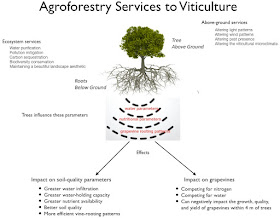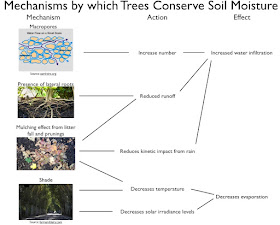Drawing heavily on Favor's Master Thesis, my recent post on Agroforestry practices in Regenerative Agriculture identified the range of above- and below-ground services provided by trees in the context of vineyards. I return to the topic to discuss the workings of those particular services and their detailed impacts.
The chart below summarizes the above- and below-ground services, with the below-ground component revolving around elements associated with water, nutrition, and grapevine rooting patterns. I treat the water aspect in this post.
Water is extremely important to the functioning of the vine plant but too much, or too little, can have adverse effects, with run-on impacts on fruit quality. Water sources for the vine include stored soilwater, effective in-season rainfall, and any water that is added by the viticulturist. According to Favor, the presence of trees in the vineyard will result in (i) increased water conservation and (ii) competition between trees and grapevines for water.
Increased Water Conservation
Favor points out that even though grapevines are a relatively drought-resistant species -- most wine regions are located in relatively low-rainfall areas -- "conserving moisture is a high priority in most vineyards." While it would be difficult for droughts to kill off the vines entirely, they can:
- stunt vegetative growth
- reduce fruit quality
- completely suppress fruit production
- yield expensive water bills in the cases where irrigation is practiced
- dry up the groundwater.
Trees in agroforestry systems conserve moisture using the mechanisms illustrated in the chart below.
Further, trees increase soil water-holding capacity by improving overall soil structure (Favor). The figure below shows the components included in a soil matrix. According to Favor, trees
 |
| Soil matrix cross-section (Source: serc.carletoon.edu) |
improve the soil structure by boosting both organic matter and microbial populations which, in turn, aid in the formation of stable aggregates and a higher incidence of micropores and macropores. These micropores and macropores are the storehouses in which the increased levels of water are held. According to Favor, agroforestry systems can increase organic matter by up to 100% with every 1% increase, yielding a 1.9% increase in soil water-holding capacity.
"All in all, agroforestry systems are able to significantly increase soil moisture, water infiltration rates, water recharge capacity, and water holding capacity" resulting in "greater drought resistance and less reliance on irrigation" (Favor).
Competition between Trees and Grapevines for Water
Favor asserts that some competition for water between trees and grapevines in an agroforestry system is inevitable. The trick here is to avoid severe water deficits for the grapevine (see table below).
Effects of Severe Water Stress on the Grape Vine
Stage | Effects |
Bud Break |
|
Post-Berry Set |
|
Post-Fruit Set |
|
Post-Harvest |
|
Source: Wample and Smithyman, Regulated deficit irrigation as a water management strategy in vitis vinifera production in Deficit Irrigation Practices, ftp://ftp.fao.org/agl/aglw/docs/wr22e.pdf%20.
Overlapping somewhat with the above, Favor sees excessive water stress:
- reducing the number of bunches per vine
- reducing photosynthesis (reduced leaf area and increased stomatol closure yield lower berry sugar levels)
- reducing both fruit and vegetative growth
- negatively affecting sugar metabolism and flavor development.
Excessive water stress, then, is to be avoided at all costs. Some water stress, on the other hand, does seem to have positive quality implications for the grapevine.
Vine water stress is created when this available water supply is reduced beyond the vines climatic needs. In areas where irrigation is allowed, viticulturists use controlled irrigation to induce vine water stress. In this scenario, the soil water resources are utilized for the plants needs up through bud break and then amounts less than required are provided to the plant (This would include effective rainfall plus irrigation). This limited water access creates a stress situation for the vine, which, in turn, results in the quality enhancements that the viticulturist seeks. That is, the soil will provide for the vine's needs with stored soil water and the vines will dive deeper -- a stressed situation -- in search of additional water when the near-in sources have been depleted.
Research carried out by UCDavis' Dr Terry Prichard on berry size and vine balance shows that:
- For a given berry size, vines grown with low irrigation have a higher anthocyanin concentration (between 15% and 33%) than those grown under higher irrigation conditions
- There is a higher concentration of skin tannins in low- versus high-irrigation environments
- Water deficits result in lower yields which, in turn, results in lower veggie characteristics and fruitier wines.
According to Favor, mild water stress has been shown to:
- Improve wine quality by increasing the sugar:acid ratio, lowering malate and total titratable acid concentrations, and increasing total soluble solids
- Increase grape phenological profiles
- Increase sugar concentration in berries
- In a study comparing the effects of 25%, 50%, 70%, and 90% soil moisture regimes, the 25% regime was found to produce the smallest berries and the highest concentrations of sugars and phenological compounds.
Trees and grapevines do impart some levels of water stress through "competition and root niche overlap" but this is more than offset by the beneficial water contributions provided by trees (as detailed in the foregoing section). Some stress is good for the vine plant; and trees in an agroforestry system will provide that. According to Favor, "given all the tradeoffs, research findings suggest that trees would not induce damagingly high levels of water stress."
I will continue in my next post with agroforestry's impact on vine nutrition parameters.


No comments:
Post a Comment